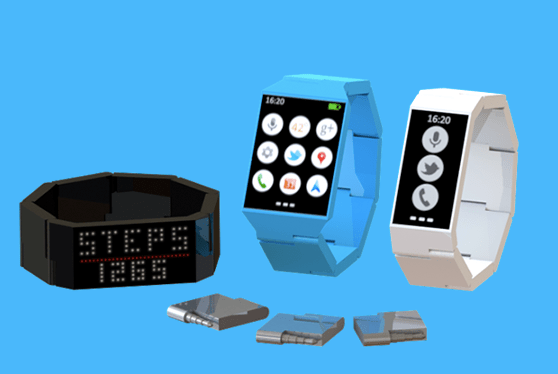Google’s Project Ara modular smartphone — itself inspired by Phonebloks — is still very much in development, with a workable modular handset not likely to appear until next year at the earliest (although Google has announced a developer conference for the concept this April).
But the concept of an open hardware platform that supports device modularity is already inspiring others to apply the block-by-block approach to another category of device: namely, wearables.
This wannabe modular smartwatch — called Blocks (demoed in the below video in concept form) — intends to offer a fully customisable wearable experience, allowing the user to choose which sensors and features make sense for their wrist, whether it’s a basic fitness band they’re after, or a more fully featured smartwatch.
The core concept is that people get to spec out a wearable to suit their particular needs, buying individual blocks such as a heart rate monitor or GPS tracker to build out the specific kind of smart band they’re after — whether that’s health-, activity- or notifications- focused.
With wearable electronics being inherently more personal than a handset (which is merely held in the hand, not fixed to the wrist), then — on the surface at least — the modular concept seems to make a lot of sense here.
Modularity could support both design personalisation and function flexibility — to allow for wearables that can suit various tastes, personalities and wrist sizes.
The technical challenges of delivering a workable modular wearable may also be less substantial than making an entirely modular smartphone — albeit, all that remains to be seen. Still, on the concept level alone, making an adaptive type of device to fit an adaptive category feels fitting.
Of course, in reality, asking people to spec out their own devices already requires them to be a little more device savvy than the average — and the freedom of choice supported by modularity inevitably introduces a degree of complexity that won’t appeal to everyone. Which may end up being the biggest challenge for any of these modular devices capturing the imagination of the mainstream.
For now, Blocks remains vapourware, as indeed does Project Ara — albeit the latter project has a hefty parent in Google. But the U.K. team behind the modular smartwatch concept say they have built a functional prototype, and plan to go the crowdfunding route to get to a shipping product — with a commercial product launch penciled in for mid-2015.
Blocks was founded in November 2013 — right after Motorola outed the Project Ara concept that’s now in house at Google (even though the rest of Motorola’s handset business has moved on to Lenovo). The founding team consisted of two students from Imperial College (a biomedical engineering undergrad and a computer science PhD student). It’s now expanded to a team of eight.
“We currently have a functional prototype that proves the concept. More specifically — that the connections are reliable enough to send data from block to block, and that the communication protocol can support the data rate at which the information is being transferred around the device,” Blocks’ Serge Vasylechko tells TechCrunch.
“The current aim is to look at design issues around Blocks and make it comfortable and appealing to wear for the user. Once that is done we can move on to full prep towards a crowdfunding campaign which we plan to release in the near future. In the longer run, we aim to release the full product itself by mid 2015, with developer editions ready before that.”
The idea for building a modular smartwatch came from wanting to build a wearable but not being able to decide which features to incorporate . “In the early days we dreamt of creating a great smartwatch but could not agree between ourselves whether it should have gesture control features (we loved the idea of MYO device and Kreyos smartwatch), or sensors targeted to health & sports tracking,” says Vasylechko. “There were too many great things we could not embed inside at once without making the watch bulky. It seemed like a big dilemma, until one day we came up with the idea of blocks.
He says the main technical obstacles the team needs to overcome to ship commercial product are mechanical stability — in terms of having robust connections between blocks — and also developing serial communications protocols so the blocks can talk to each other.
“There are two major obstacles to overcome. Mechanical stability — such as the snap mechanism between blocks, their sturdiness and water resistance (do remember that Galaxy Gear is not water-resistant, which was a big criticism, yet we would like our device to be). The second is electronics — there is a need for serial communication protocols betweens blocks. Unlike the fully embedded electronics in conventional smartwatches, there is a limit on the number of connections the blocks can be hosting between themselves, as they are not all on a single chip,” he says.
“The current [prototype] version is made from 3D printed blocks which embed a modified commercial microcontroller hardware inside the core, and other electronics in connecting blocks. We are aiming to make the second prototype based on the feedback we get.”
It’s not clear which OS Blocks would run but the team behind it have run tests on Android, according to Vasylechko. Both the Blocks hardware and software will be open platforms for developers to build their own blocks and apps.
Pricing wise, Vasylechko says a Blocks “package” that consists of processor, battery and display blocks would have a similar price-tag to the Pebble smartwatch. “The price for additional blocks will vary by functionality, but be much lower than the former,” he adds.
How is Blocks being funding at present? University backing and “personal funds” have kept it going since November. But Vasylechko says it will be taking to Kickstarter soon to keep the money flowing so it can get this ambitious concept to market.
